As a dog owner, you want your furry friend’s teeth to be healthy and strong. A dog dental chart is a great tool for this. Adult dogs have 42 teeth, including incisors, canines, premolars, and molars. Knowing each tooth’s purpose is key for good dental care.
Table of Contents
Using a dog dental chart helps spot tooth problems early. This can prevent issues like periodontal disease, tooth decay, and gum disease. These problems affect nearly 90% of dogs by age 3.
A canine dental chart shows your dog’s teeth in detail. It helps track changes in their dental health. Regular dental check-ups, every 6-12 months, are vital for good dental health.
Sharing your dog’s dental chart with your vet can improve their care. This ensures they get the best treatment. With a dog dental chart and regular care, you can keep your dog’s teeth clean and healthy.
By actively caring for your dog’s teeth, you can prevent dental issues. This ensures they live a happy, healthy life. A dog dental chart is a crucial part of this care. Understanding your dog’s teeth and how to care for them helps prevent dental problems.
Understanding Your Dog’s Dental Chart
As a dog owner, knowing your dog’s dental chart is key. It helps you care for their teeth and spot dental problems early. Keeping your dog’s teeth clean is vital for their health. Dogs have 42 permanent teeth, including incisors, canines, premolars, and molars.
Dogs have 12 incisors, 4 canines, 16 premolars, and 10 molars. Knowing this helps you clean their teeth properly. It’s important for their oral health.
It’s wise to take your dog for regular dental checks. This helps find gum disease early. Veterinary Centers of America say most of a molar is hidden, showing how they chew hard foods. By caring for your dog’s teeth, you can avoid dental issues and keep them healthy.
| Teeth Type | Number | Location |
|---|---|---|
| Incisors | 12 | 6 top, 6 bottom |
| Canines | 4 | 2 top, 2 bottom |
| Premolars | 16 | 8 top, 8 bottom |
| Molars | 10 | 4 top, 6 bottom |
The Importance of Regular Dental Check-ups
As a dog owner, you want your pet to be healthy and happy. Regular dental check-ups are key to keeping your dog’s veterinary dental health in top shape. By age 3, about 80% of dogs show signs of periodontal disease. This shows how important it is to take care of their teeth early.
A dog dental chart can help you keep track of your dog’s dental health. It helps spot problems early. This way, you can take action before things get worse.
Regular dental check-ups can stop serious periodontal disease. This disease can cause kidney, liver, and heart problems. The American Veterinary Dental College says anesthesia-free dental cleanings aren’t enough. They need to clean below the gumline to really help.
By focusing on your dog’s dental health, you can prevent many problems. This includes periodontal disease, tooth decay, and gum disease. It keeps your dog’s teeth strong and healthy.
- Early identification of dental issues, reducing treatment costs and preventing more severe health issues
- Prevention of advanced periodontal disease, which can lead to additional health issues
- Reduced risk of systemic diseases, such as heart disease and kidney disease
By making your dog’s veterinary dental health a priority, you can ensure they live a long, happy life. Use a dog dental chart to track their dental health. This way, you can stay on top of their canine dental care.
Common Dental Problems in Dogs
As a dog owner, knowing about common dental issues is key. Periodontal disease, caused by plaque and tartar, is a big problem. Regular cleaning is vital to stop it. Good oral care is more than just fresh breath; it’s about your dog’s health.
Signs of periodontal disease include bad breath, yellow or brown teeth, and loose teeth. If ignored, it can cause serious health issues. Tooth decay and gum disease also hurt dogs, causing pain. Knowing the signs helps you prevent these problems and keep your dog’s teeth healthy.
About 80% of dogs get periodontal disease by age 3. Tartar forms quickly after brushing stops. Almost 90% of dogs show signs of gingivitis by 3. Dogs need a professional dental cleaning yearly, sometimes every 6 months.
| Dental Problem | Prevalence |
|---|---|
| Periodontal Disease | 80% of dogs by age 3 |
| Gingivitis | 90% of dogs by age 3 |
| Tooth Decay | Less than 10% of all dental problems |
By focusing on oral hygiene and regular dental visits, you can prevent these issues. This ensures your dog stays happy and healthy.
How to Read a Professional Dog Dental Chart
Knowing how to read a dog dental chart is key for any pet owner. It helps in caring for your dog’s dental health. The chart shows the different teeth dogs have, like incisors and molars. It uses a special system to identify teeth during exams.
The quadrant numbers are defined as follows:
- 100: Right maxillary
- 200: Left maxillary
- 300: Left mandibular
- 400: Right mandibular
Puppies have deciduous teeth, numbered from 500 to 800. By understanding the chart, you can better care for your dog’s teeth. This helps prevent dental problems.
Here is a table summarizing the types of teeth and their functions:
| Teeth Type | Function |
|---|---|
| Incisors | Scraping, removing parasites |
| Canines | Piercing, tearing |
| Pre-molars | Shredding, chewing |
| Molars | Breaking down hard foods |
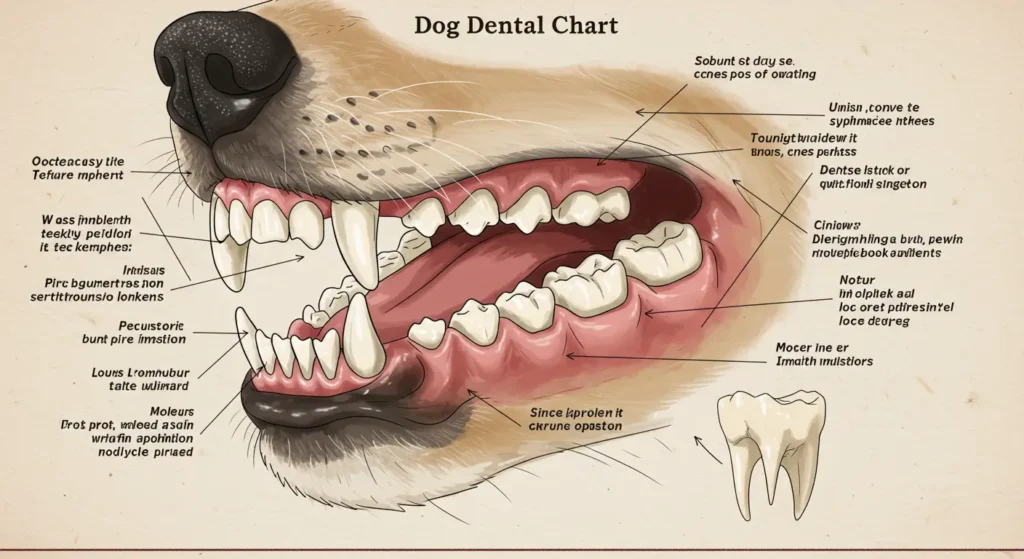
Regular dental check-ups with a vet are vital. They help keep your dog’s teeth healthy. By learning to read a dog dental chart, you can better care for your dog’s teeth. This prevents dental problems.
Essential Tools for At-Home Dental Care
Having the right tools is key for cleaning your dog’s teeth at home. It’s important to keep your dog’s teeth and gums healthy. Knowing about dog dental anatomy helps you pick the best tools for home care.
Start with a dog-safe toothbrush and toothpaste. Dental chews and toys also help remove plaque and tartar. The Veterinary Oral Health Council (VOHC) has approved 32 dog and 12 cat dental products. These products have been shown to reduce plaque and tartar by at least 20%.
Some must-have tools for at-home dental care include:
- Dental chews and toys
- Water additives and oral sprays
- Toothbrushes and toothpastes made for dogs
These tools help keep your dog’s gums healthy and prevent bad breath. It’s crucial to use products made for dogs, as human toothpaste can harm them.
Using these tools and sticking to a dental care routine can keep your dog’s teeth and gums healthy. Always talk to your vet for advice on the best tools and methods for your dog.
| Tool | Description |
|---|---|
| Dental Chews | Help remove plaque and tartar from teeth |
| Water Additives | Reduce tartar accumulation and freshen breath |
| Toothbrushes and Toothpastes | Specifically designed for dogs to promote healthy gums and teeth |
Step-by-Step Guide to Brushing Your Dog’s Teeth
As a dog owner, you are key to your pet’s oral health. Brushing their teeth is a big part of this. It helps avoid pet oral hygiene problems and keeps their dog dental chart healthy. First, pick the right toothbrush and toothpaste for your dog.
Choose a toothbrush with soft bristles to avoid gum damage. Use enzymatic toothpaste, as it fights plaque and is safe if swallowed. With the right tools, you can start brushing your dog’s teeth.
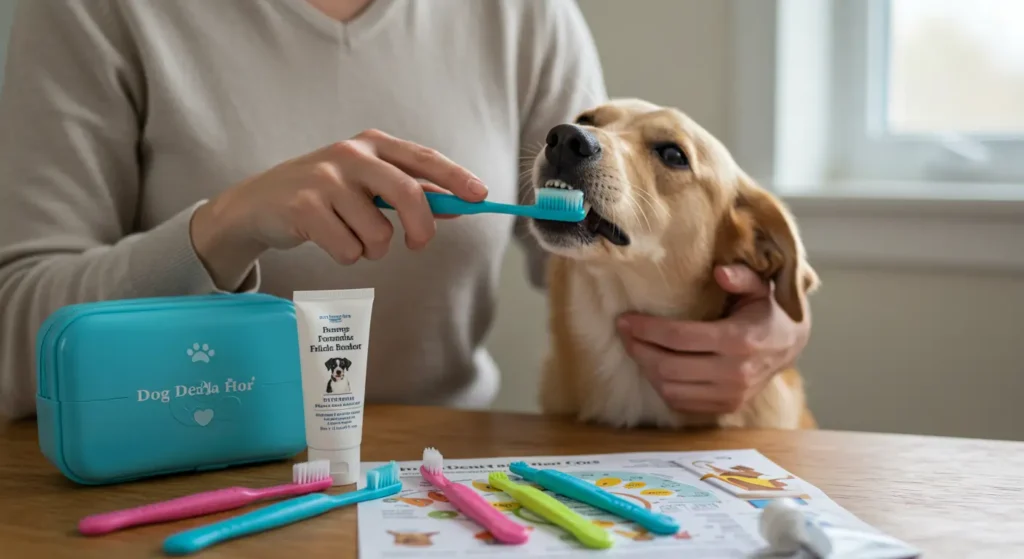
- Start by getting your dog used to the toothbrush and toothpaste. Use a damp cloth or gauze to clean their teeth and gums.
- Slowly introduce the toothbrush, moving it back and forth in an oval pattern. Clean three to four teeth at a time.
- Hold the toothbrush at a 45-degree angle at the gum line. This helps clean the teeth and gums well.
Brushing your dog’s teeth regularly, ideally twice a day, can greatly lower dental disease risks. By following these steps and making canine dental care a priority, you can keep your dog’s teeth and gums healthy. This prevents common pet oral hygiene issues.
Signs of Dental Emergency in Dogs
As a dog owner, knowing the signs of a dental emergency is key. Periodontal disease can cause severe pain, bleeding, or swelling. These need quick vet care. Regular tooth cleaning and good oral hygiene can prevent these problems.
If your dog shows signs like severe pain, bleeding, or swelling, get vet help fast. Your vet can give emergency care, like pain relief and treating underlying issues. Quick action helps avoid bigger health problems and keeps your dog’s teeth healthy.
When to Seek Immediate Veterinary Care
Some common signs of dental emergency in dogs include:
- Severe dental pain
- Bleeding or swelling in the mouth
- Difficulty eating or swallowing
Emergency First Aid for Dental Issues
In a dental emergency, your vet may offer emergency care. This includes pain relief and treating any underlying issues. It’s important to follow their advice and keep up with regular check-ups. This helps keep your dog’s mouth healthy and prevents periodontal disease.
Preventive Dental Care Strategies
As a dog owner, you are key to your dog’s oral health. Regular dental visits, at-home care, and a balanced diet are crucial. These steps can greatly lower the risk of dental issues like periodontal disease and tooth decay.
A dog dental chart helps track your dog’s dental health. Keeping up with dental care ensures your dog’s teeth stay healthy. Pet oral hygiene is vital to prevent dental problems. Regular cleanings can catch issues like cavities and abscesses early.
Some important preventive dental care steps include:
- Regular dental check-ups
- At-home dental care, like brushing your dog’s teeth
- A balanced diet that supports oral health
By using these strategies, you can lower dental problem risks. This keeps your dog’s teeth strong and healthy.
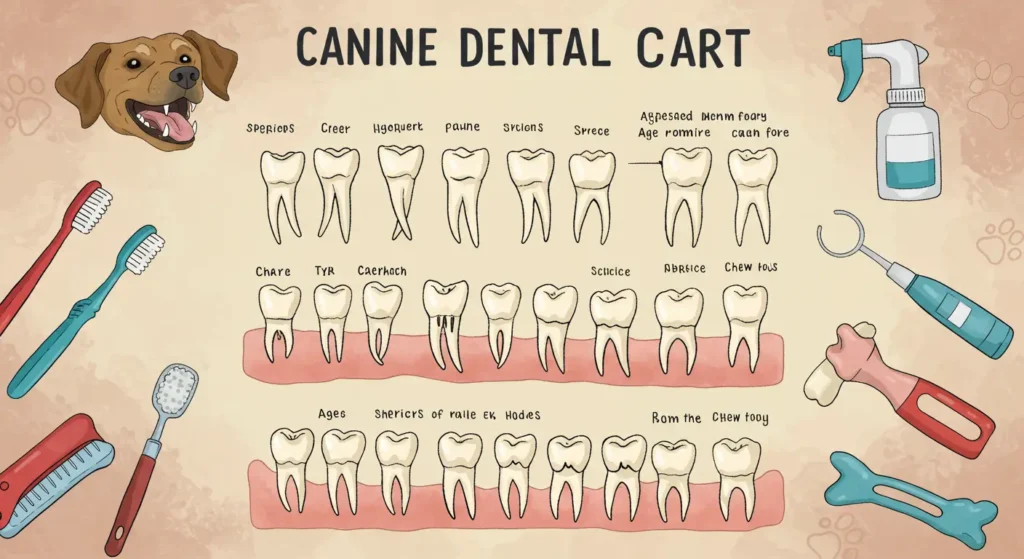
Preventive dental care is key for your dog’s health and happiness. By actively caring for your dog’s teeth, you ensure they live a long, happy life.
| Preventive Measure | Benefits |
|---|---|
| Regular dental check-ups | Early detection of dental problems, reduced risk of periodontal disease |
| At-home dental care | Reduced risk of dental disease, fresh breath, and healthy gums |
| Balanced diet | Supports oral health, reduces risk of dental problems |
Breed-Specific Dental Concerns
As a dog owner, knowing about different breeds’ dental needs is key. Your dog’s dog dental anatomy greatly affects their dental health. Some breeds are more likely to get periodontal disease in dogs because of their body shape or genes.
Keeping your dog’s teeth clean is vital to avoid dental issues. But, some breeds need their teeth cleaned more often because of their teeth shape. For instance, small breeds often face dental crowding. This can lead to periodontal disease in dogs.
Here are some dental concerns specific to certain breeds:
- Small breeds: prone to dental crowding and periodontal disease in dogs
- Large breeds: may experience tooth fractures and dog dental anatomy issues
- Brachycephalic breeds: can have unique dental concerns due to their short, flat face
Knowing about these dental issues can help you prevent problems. Regular tooth cleaning for dogs and vet visits are crucial. They help spot any dental issues early.
Diet’s Impact on Dental Health
As a dog owner, you are key to your dog’s dental health. A balanced diet helps prevent dental issues by reducing plaque and tartar. This is crucial for pet oral hygiene. Research shows 80% of dogs will have dental disease by age 2, making regular dog dental chart check-ups essential.
Choosing a high-quality dog food is important. Foods like Hill’s dental foods, with the VOHC seal, help keep teeth healthy. They are designed to clean teeth better by staying in contact longer.
- Feed a high-quality dog food designed for oral health
- Give dental chews and toys to reduce plaque
- Make sure your dog always has fresh water to rinse away bacteria
Combining a balanced diet with regular pet oral hygiene practices is key. It prevents dental problems and keeps your dog’s teeth strong. A regular dental care routine can also save money on dental treatments, making it a vital investment in your dog’s health.
| Diet Type | Oral Health Benefits |
|---|---|
| Hill’s Prescription Diet t/d | Reduces plaque and tartar buildup, promotes healthy gums |
| Science Diet Oral Care | Helps reduce bad breath, supports overall oral health |
Professional Dental Cleaning Procedures
Regular dental cleanings are key for your dog’s health. They remove plaque and tartar, keeping gums healthy and preventing dental problems.
A dental cleaning includes a thorough check-up and X-rays. The cleaning itself removes plaque and tartar. Then, the teeth are polished and cleaned out further.
What to Expect During Cleaning
Your vet will use special tools to clean your dog’s teeth. This includes ultrasonic tools and polishers to make the teeth smooth.
Post-Cleaning Care Instructions
After the cleaning, your vet will give you care tips. This includes brushing your dog’s teeth and using dental chews or toys.
Frequency Recommendations
How often your dog needs a cleaning depends on their health. Your vet might suggest cleanings every 6-12 months to keep teeth clean.
| Procedure | Frequency | Importance |
|---|---|---|
| Professional dental cleaning | Every 6-12 months | Essential for maintaining veterinary dental health |
| At-home dental care | Daily | Helps prevent plaque and tartar buildup |
Conclusion: Maintaining Your Dog’s Dental Health for Life
Keeping your dog’s teeth healthy is a big responsibility but very important. By following the tips in this article, you can help your dog’s teeth stay strong. Regular vet visits and daily care at home are key to avoiding dental problems.
Brushing your dog’s teeth often, giving them dental chews, and a balanced diet are all important. These actions help keep their teeth and mouth healthy. Taking care of your dog’s teeth now can save you a lot of trouble and money later. It’s a way to show you care about their health and happiness.
FAQ
What is a dog dental chart and why is it important?
A dog dental chart shows the different teeth dogs have. It’s key for proper care and spotting dental issues. Regular dental checks and home care can prevent problems like periodontal disease and tooth decay.
What are the key features of a dog’s dental chart?
A dog’s dental chart shows adult tooth count and layout. It also explains puppy and adult teeth differences. Knowing about canine teeth helps in caring for your dog’s teeth and preventing dental issues.
Why are regular dental check-ups important for dogs?
Regular dental check-ups keep your dog’s mouth healthy. Your vet can spot issues and guide on home care. This prevents problems like periodontal disease and tooth decay.
What are the most common dental problems in dogs?
Common dental issues in dogs include periodontal disease, tooth decay, and gum disease. These can cause bad breath and pain. If not treated, they can lead to serious health issues.
How can I read and understand a professional dog dental chart?
Understanding a dog dental chart is crucial for pet owners. It shows the different teeth dogs have. Knowing the modified triadan system helps in caring for your dog’s teeth and preventing dental problems.
What are the essential tools for at-home dental care for dogs?
For at-home dental care, you need toothbrushes, dental chews, and water additives. These tools help remove plaque and tartar. Always use dog-specific products, as human toothpaste is toxic.
How do I properly brush my dog’s teeth?
Brushing your dog’s teeth is vital for their oral health. Use the right toothbrush and toothpaste. Brush regularly to prevent dental problems.
What are the signs of a dental emergency in dogs?
Dental emergencies in dogs include severe pain, bleeding, or swelling. Seek immediate vet care if you notice these signs. Your vet can provide emergency care and pain relief.
What are some preventive dental care strategies for dogs?
Preventive dental care includes regular check-ups and at-home care. A balanced diet also helps. Staying on top of dental health prevents dental problems.
Are there any breed-specific dental concerns I should be aware of?
Yes, some breeds face unique dental issues. Small, large, and brachycephalic breeds have specific concerns. Knowing these can help prevent dental problems.
How does diet affect a dog’s dental health?
Diet is key to your dog’s dental health. A balanced diet reduces plaque and tartar buildup. Choose high-quality dog food to keep their teeth healthy.
What can I expect during a professional dental cleaning for my dog?
Professional dental cleanings are vital for your dog’s oral health. Your vet will remove plaque and tartar and promote gum health. Follow post-cleaning care and schedule regular cleanings to keep their teeth healthy.
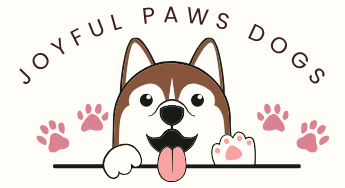
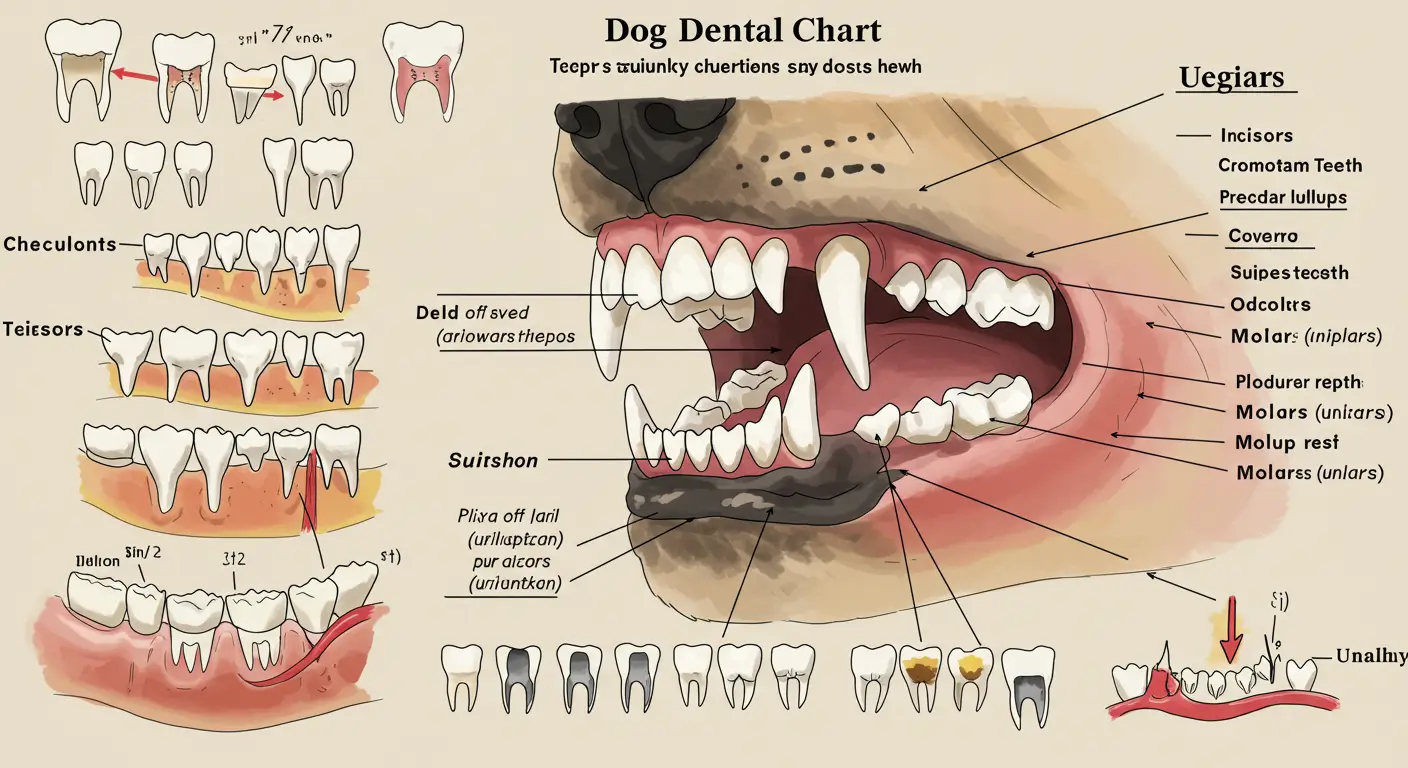
1 thought on “Dog Dental Chart Tips for Identifying and Caring for Canine Teeth”
Comments are closed.